Analysis of the Spatial and Temporal Evolution Patterns of Grassland Health and Its Driving Factors in Xilingol
Abstract
1. Introduction
2. Materials and Methods
2.1. Study Area and Data Source
2.1.1. Study Area
2.1.2. Data Source
2.2. Materials
2.2.1. Analysis of Vegetation Variation Trends
2.2.2. Geodetector Model
- (1)
- Factor detector
- (2)
- Interaction detector
- (3)
- Risk detector
- (4)
- Driving factor selection
3. Results
3.1. Spatial and Temporal Variation Patterns of NDVI in Xilingol
3.1.1. Spatial Distribution Characteristics of NDVI
3.1.2. Temporal Variation Characteristics of NDVI in Xilingol
3.1.3. Variation Trends of NDVI in Xilingol
3.2. The Relationship between NDVI and Driving Factors in Xilingol
3.2.1. Detection of Differences in the Explanatory Credibility of Different Factors
3.2.2. Interaction Detection of Different Driving Factors
3.2.3. Relationship between the Dominant Driving Factors and NDVI
4. Discussion
4.1. Dominant Driving Factors of Grassland Health in Xilingol
4.2. Impact of Human Activities on Grassland Health
4.3. The Differences among Interactions of the Natrual and Anthropogenic Factors
5. Conclusions
Author Contributions
Funding
Data Availability Statement
Conflicts of Interest
References
- Fang, J.; Yu, G.; Liu, L.; Hu, S.; Chapin, F.S., III. Climate change, human impacts, and carbon sequestration in China. Proc. Natl. Acad. Sci. USA 2018, 115, 4015–4020. [Google Scholar] [CrossRef]
- Bengtsson, J.; Bullock, J.M.; Egoh, B.; Everson, C.; Everson, T.; O’Connor, T.; O’Farrell, P.J.; Smith, H.G.; Lindborg, R. Grasslands-more important for ecosystem services than you might think. Ecosphere 2019, 10, e02582. [Google Scholar] [CrossRef]
- Fensholt, R.; Rasmussen, K.; Nielsen, T.T.; Mbow, C. Evaluation of earth observation based long term vegetation trends—Intercomparing NDVI time series trend analysis consistency of Sahel from AVHRR GIMMS, Terra MODIS and SPOT VGT data. Remote Sens. Environ. 2009, 113, 1886–1898. [Google Scholar] [CrossRef]
- Bento, V.A.; Gouveia, C.M.; DaCamara, C.C.; Libonati, R.; Trigo, I.F. The roles of NDVI and Land Surface Temperature when using the Vegetation Health Index over dry regions. Glob. Planet. Change 2020, 190, 103198. [Google Scholar] [CrossRef]
- Soubry, I.; Doan, T.; Chu, T.; Guo, X. A Systematic Review on the Integration of Remote Sensing and GIS to Forest and Grassland Ecosystem Health Attributes, Indicators, and Measures. Remote Sens. 2021, 13, 3262. [Google Scholar] [CrossRef]
- Meng, X.; Gao, X.; Li, S.; Lei, J. Spatial and Temporal Characteristics of Vegetation NDVI Changes and the Driving Forces in Mongolia during 1982–2015. Remote Sens. 2020, 12, 603. [Google Scholar] [CrossRef]
- Gandhi, G.M.; Parthiban, S.; Thummalu, N.; Christy, A. Ndvi: Vegetation Change Detection Using Remote Sensing and Gis—A Case Study of Vellore District. Procedia Comput. Sci. 2015, 57, 1199–1210. [Google Scholar] [CrossRef]
- Bodner, G.S.; Robles, M.D. Enduring a decade of drought: Patterns and drivers of vegetation change in a semi-arid grassland. J. Arid Environ. 2017, 136, 1–14. [Google Scholar] [CrossRef]
- Ning, D.; Yuan, M.; Wu, L.; Zhang, Y.; Guo, X.; Zhou, X.; Yang, Y.; Arkin, A.P.; Firestone, M.K.; Zhou, J. A quantitative framework reveals ecological drivers of grassland microbial community assembly in response to warming. Nat. Commun. 2020, 11, 4717. [Google Scholar] [CrossRef]
- Sun, Y.; Wan, H.; Zhao, Y.; Chen, S.; Bai, Y. Spatial patterns and drivers of root turnover in grassland ecosystems in China. Chin. J. Plant Ecol. 2018, 42, 337–348. [Google Scholar]
- Wang, J.-F.; Li, X.-H.; Christakos, G.; Liao, Y.-L.; Zhang, T.; Gu, X.; Zheng, X.-Y. Geographical detectors-based health risk assessment and its application in the neural tube defects study of the Heshun region, China. Int. J. Geogr. Inf. Sci. 2010, 24, 107–127. [Google Scholar] [CrossRef]
- Wang, J.-F.; Zhang, T.-L.; Fu, B.-J. A measure of spatial stratified heterogeneity. Ecol. Indic. 2016, 67, 250–256. [Google Scholar] [CrossRef]
- Wang, J.; Xu, C. Geodetector: Principle and prospective. Acta Geogr. Sin. 2017, 72, 116–134. [Google Scholar]
- Ma, M.; Zhang, S.; Wei, B. Temporal and spatial pattern of grassland degradation and its determinants for recent 30 years in Xilingol. Chin. J. Grassl. 2017, 39, 86–93. [Google Scholar]
- Tian, Z.; Zhang, A.; Wang, H.; Cao, Y.; Fan, Q. Temporal and spatial variations of EVI and its response to influence of climate with different grassland types in Xilin Gol League. Pratacultural. Sci. 2019, 36, 346–358. [Google Scholar]
- Zhou, W.; Yang, H.; Huang, L.; Chen, C.; Lin, X.; Hu, Z.; Li, J. Grassland degradation remote sensing monitoring and driving factors quantitative assessment in China from 1982 to 2010. Ecol. Indic. 2017, 83, 303–313. [Google Scholar] [CrossRef]
- Fang, L.; Wang, L.; Chen, W.; Sun, J.; Cao, Q.; Wang, S.; Wang, L. Identifying the impacts of natural and human factors on ecosystem service in the Yangtze and Yellow River Basins. J. Clean. Prod. 2021, 314, 127995. [Google Scholar] [CrossRef]
- Gök, G.; Gürbüz, O.A. Application of geostatistics for grid and random sampling schemes for a grassland in Nigde, Turkey. Environ. Monit. Assess. 2020, 192, 300. [Google Scholar] [CrossRef]
- Liu, Y.; Liu, S.; Sun, Y.; Li, M.; An, Y.; Shi, F. Spatial differentiation of the NPP and NDVI and its influencing factors vary with grassland type on the Qinghai-Tibet Plateau. Environ. Monit. Assess. 2021, 193, 48. [Google Scholar] [CrossRef]
- Dong, Z.; Zhang, J.; Tong, Z.; Han, A.; Zhi, F. Ecological security assessment of Xilingol grassland in China using DPSIRM model. Ecol. Indic. 2022, 143, 109336. [Google Scholar] [CrossRef]
- Li, W.J.; Ali, S.H.; Zhang, Q. Property rights and grassland degradation: A study of the Xilingol Pasture, Inner Mongolia, China. J. Environ. Manag. 2007, 85, 461–470. [Google Scholar] [CrossRef]
- Chi, D.; Wang, H.; Li, X.; Liu, H.; Li, X. Assessing the effects of grazing on variations of vegetation NPP in the Xilingol Grassland, China, using a grazing pressure index. Ecol. Indic. 2018, 88, 372–383. [Google Scholar] [CrossRef]
- Kawamura, K.; Akiyama, T.; Yokota, H.-O.; Tsutsumi, M.; Yasuda, T.; Watanabe, O.; Wang, S. Quantifying grazing intensities using geographic information systems and satellite remote sensing in the Xilingol steppe region, Inner Mongolia, China. Agric. Ecosyst. Environ. 2005, 107, 83–93. [Google Scholar] [CrossRef]
- Augustine, D.J.; Derner, J.D. Long-Term Effects of Black-Tailed Prairie Dogs on Livestock Grazing Distribution and Mass Gain. J. Wildl. Manag. 2021, 85, 1332–1343. [Google Scholar] [CrossRef]
- YunXiang, J.; Bin, X.; XiuChun, Y.; JinYa, L.; Wang, D.; Ma, H. Remote sensing dynamic estimation of grass production in Xilinguole, Inner Mongolia. Sci. Sin. Vitae 2011, 41, 1185–1195. [Google Scholar]
- Chen, T.; Feng, Z.; Zhao, H.; Wu, K. Identification of ecosystem service bundles and driving factors in Beijing and its surrounding areas. Sci. Total Environ. 2019, 711, 134687. [Google Scholar] [CrossRef]
- Xu, Y.; Xu, X.; Tang, Q. Human activity intensity of land surface: Concept, methods and application in China. J. Geogr. Sci. 2016, 26, 1349–1361. [Google Scholar] [CrossRef]
- Zhang, Y.; Xu, D.; Wang, Z.; Zhang, X. The interaction of driving factors for the change of windbreak and sand-fixing service function in Xilingol League between 2000 and 2015. Acta Ecol. Sin. 2021, 41, 603–614. [Google Scholar]
- Hui, J.; Chen, Z.; Ye, B.; Shi, C.; Bai, Z. Remote Sensing Monitoring of the Spatial Pattern of Greening and Browning in Xilin Gol Grassland and Its Response to Climate and Human Activities. Remote Sens. 2022, 14, 1765. [Google Scholar] [CrossRef]
- Stow, D.; Daeschner, S.; Hope, A.; Douglas, D.; Petersen, A.; Myneni, R.; Zhou, L.; Oechel, W. Variability of the Seasonally Integrated Normalized Difference Vegetation Index Across the North Slope of Alaska in the 1990s. Int. J. Remote Sens. 2003, 24, 1111–1117. [Google Scholar] [CrossRef]
- Guo, H.; Wang, X.; Guo, Z.; Chen, S. Assessing Snow Phenology and Its Environmental Driving Factors in Northeast China. Remote Sens. 2022, 14, 262. [Google Scholar] [CrossRef]
- Ye, J.; Hu, Y.; Zhen, L.; Wang, H.; Zhang, Y. Analysis on Land-Use Change and Its Driving Mechanism in Xilingol, China, during 2000–2020 Using the Google Earth Engine. Remote Sens. 2021, 13, 5134. [Google Scholar] [CrossRef]
- Wu, N.; Liu, A.; Ye, R.; Yu, D.; Du, W.; Chaolumeng, Q.; Liu, G.; Yu, S. Quantitative analysis of relative impacts of climate change and human activities on Xilingol grassland in recent 40 years. Glob. Ecol. Conserv. 2021, 32, e01884. [Google Scholar] [CrossRef]
- Zhao, R.; Xiao, R.; Wan, H.; Liu, H.; Gao, S.; Liu, S.; Fu, Z.; Tan, C.; Wen, R.; Tang, H. Grassland change monitoring and driving force analysis in Xilingol League. China Environ. Sci. 2017, 37, 4734–4743. [Google Scholar]
- Xie, Y.; Sha, Z. Quantitative Analysis of Driving Factors of Grassland Degradation: A Case Study in Xilin River Basin, Inner Mongolia. Sci. World J. 2012, 2012, 169724. [Google Scholar] [CrossRef]
- Sun, B.; Li, Z.; Gao, Z.; Guo, Z.; Wang, B.; Hu, X.; Bai, L. Grassland degradation and restoration monitoring and driving forces analysis based on long time-series remote sensing data in Xilin Gol League. Acta Ecol. Sin. 2017, 37, 219–228. [Google Scholar] [CrossRef]
- Hang, Y.; Bao, G.; Bao, Y.; Burenjirigala, D.A. Spatiotemporal changes of vegetation coverage in Xilin Gol grassland and its responses to climate change during 2000–2010. Acta Agrestia Sin. 2014, 22, 1194. [Google Scholar]
- Meng, M.; Huang, N.; Wu, M.; Pei, J.; Wang, J.; Niu, Z. Vegetation change in response to climate factors and human activities on the Mongolian Plateau. PeerJ 2019, 7, e7735. [Google Scholar] [CrossRef]
- Gao, T.; Yang, X.; Jin, Y.; Ma, H.; Li, J.; Yu, H.; Yu, Q.; Zheng, X.; Xu, B. Spatio-Temporal Variation in Vegetation Biomass and Its Relationships with Climate Factors in the Xilingol Grasslands, Northern China. PLoS ONE 2013, 8, e83824. [Google Scholar] [CrossRef]
- Yiruhan; Ailikun; Ma, Z.; Shiyomi, M. Forty-eight-year climatology of air temperature and precipitation changes in Xilinhot, Xilingol steppe (Inner Mongolia), China. Grassl. Sci. 2011, 57, 168–172. [Google Scholar] [CrossRef]
- Ma, Q.; Zhang, J.; Sun, C.; Zhang, F.; Wu, R.; Wu, L. Drought characteristics and prediction during pasture growing season in Xilingol grassland, northern China. Arch. Meteorol. Geophys. Bioclimatol. Ser. B 2017, 133, 165–178. [Google Scholar] [CrossRef]

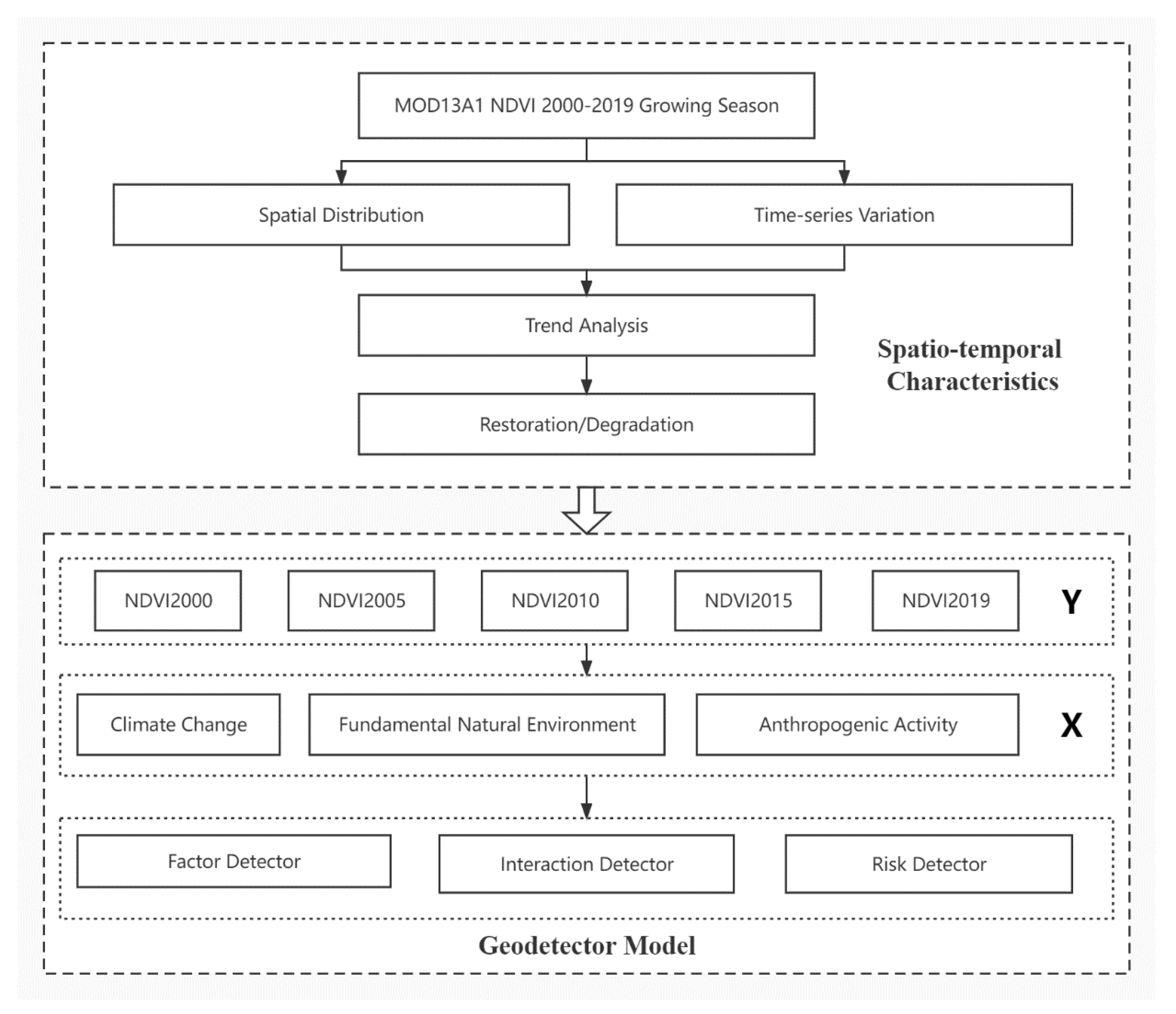
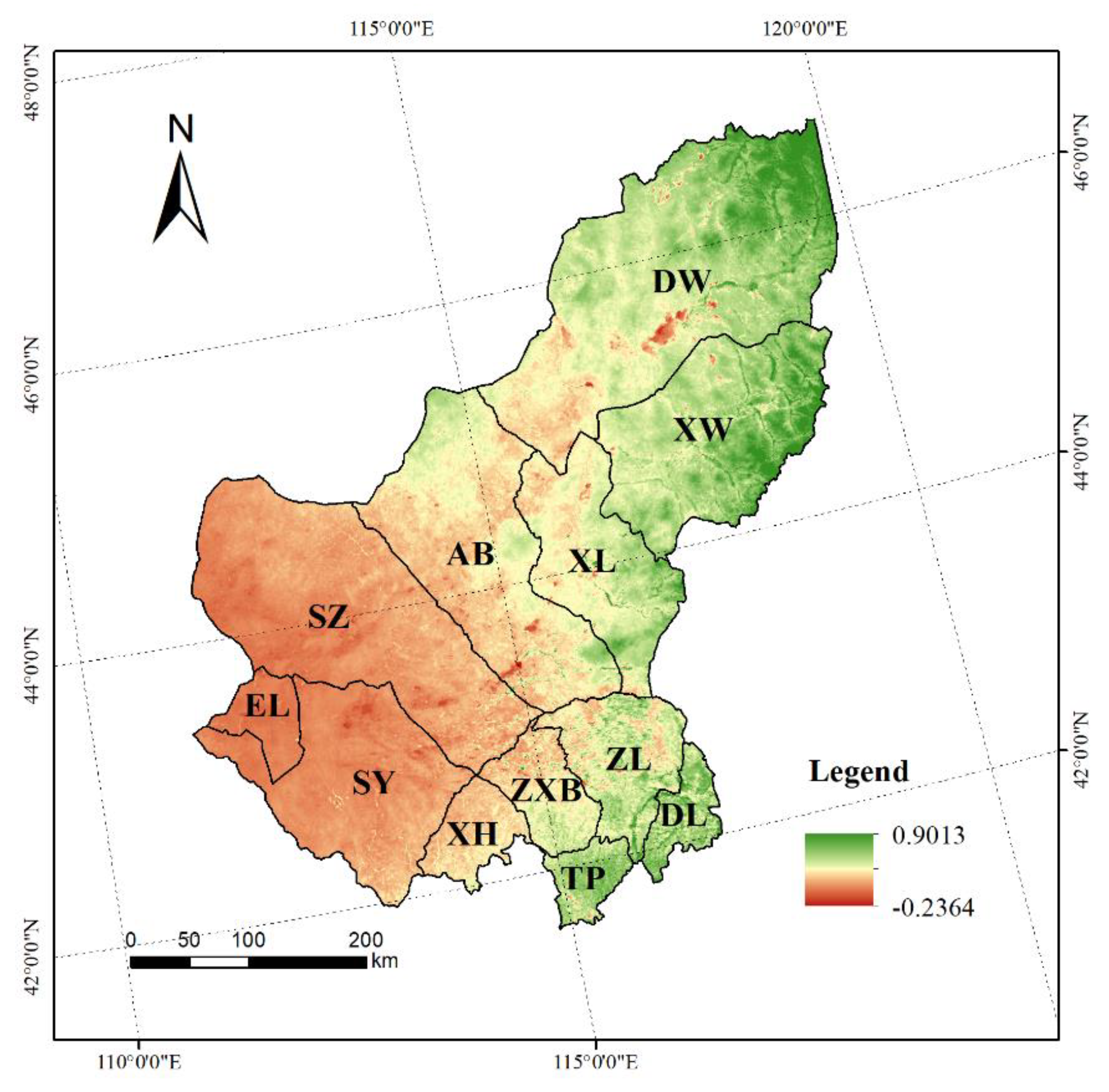
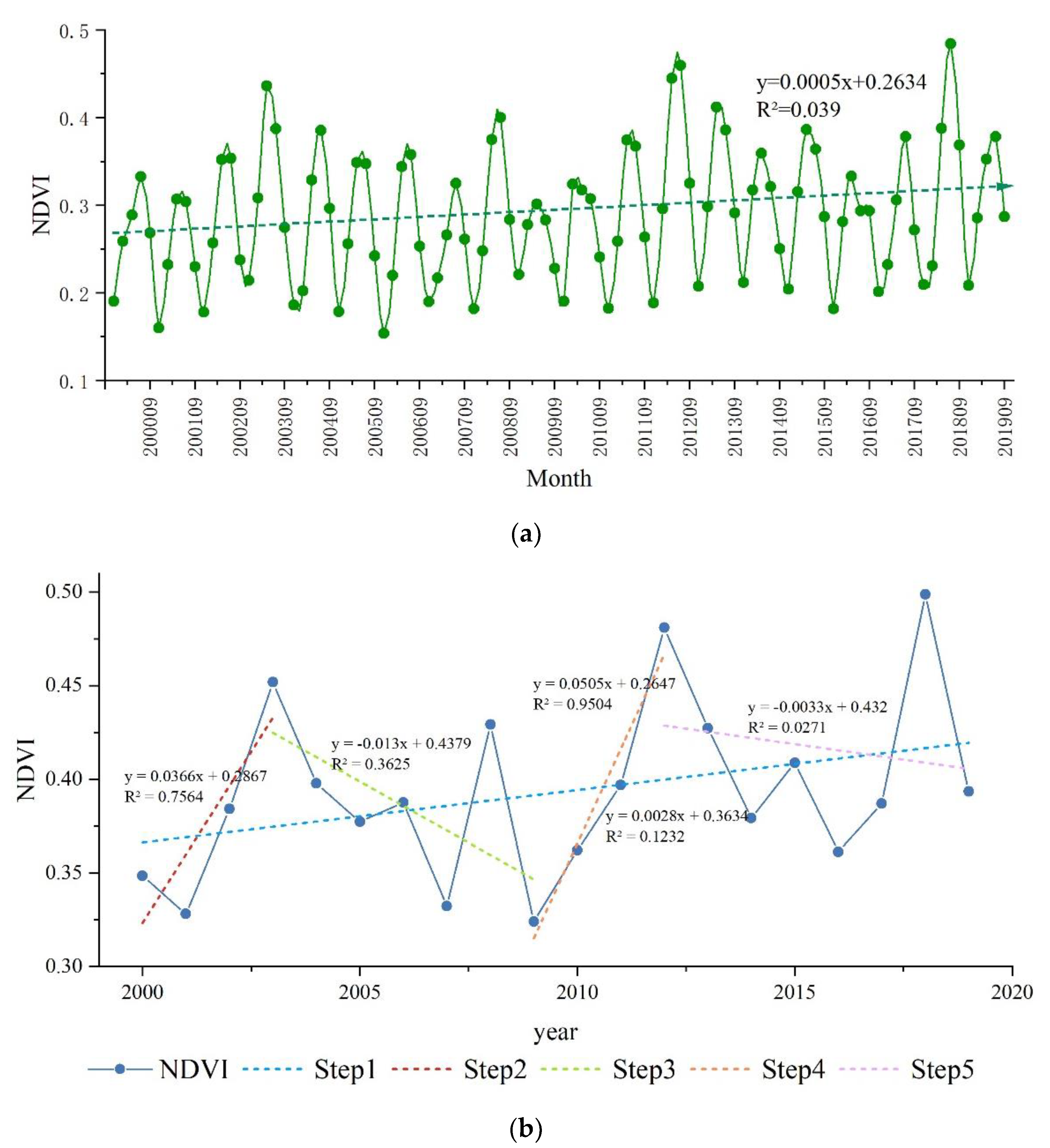
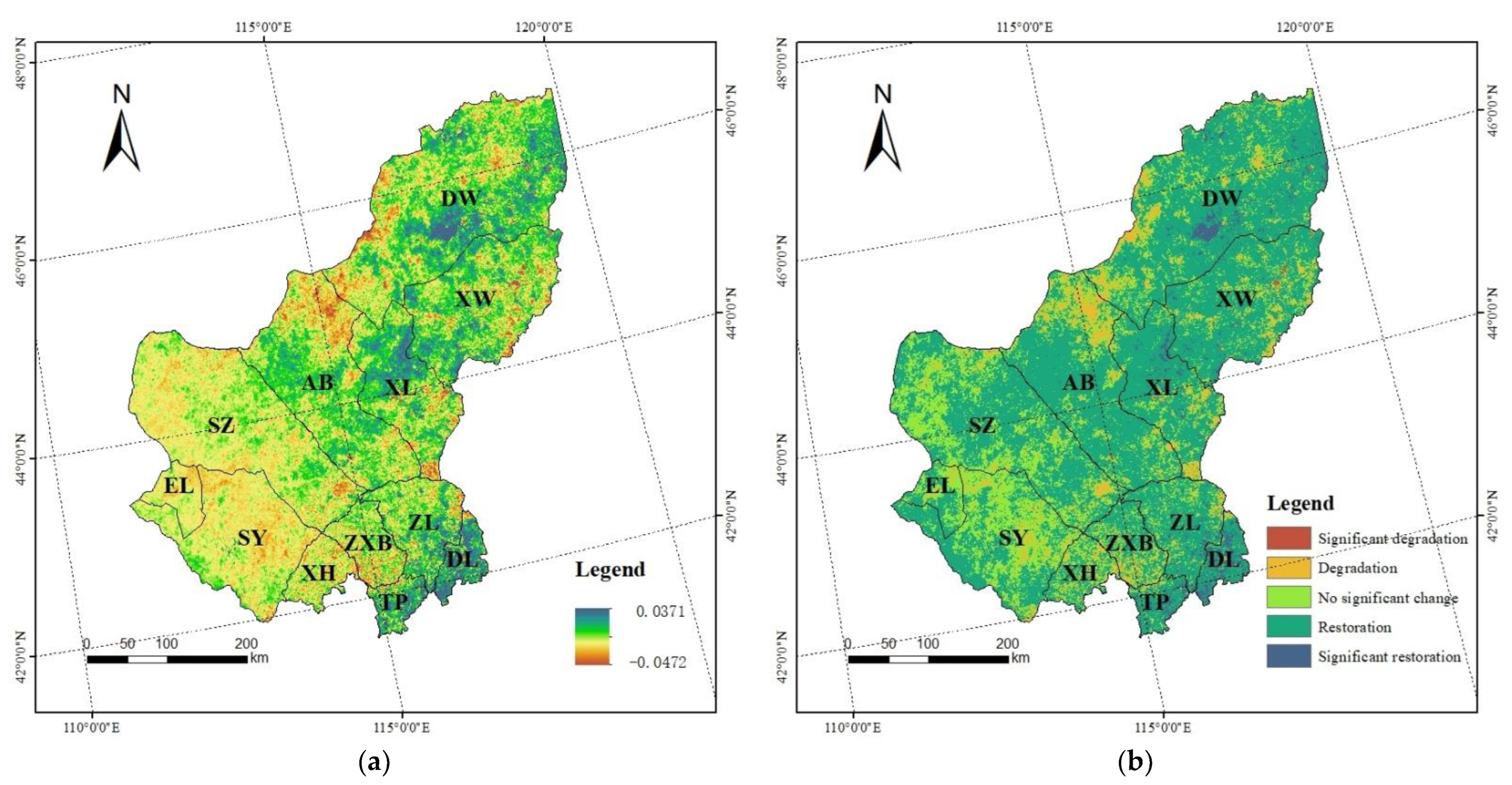
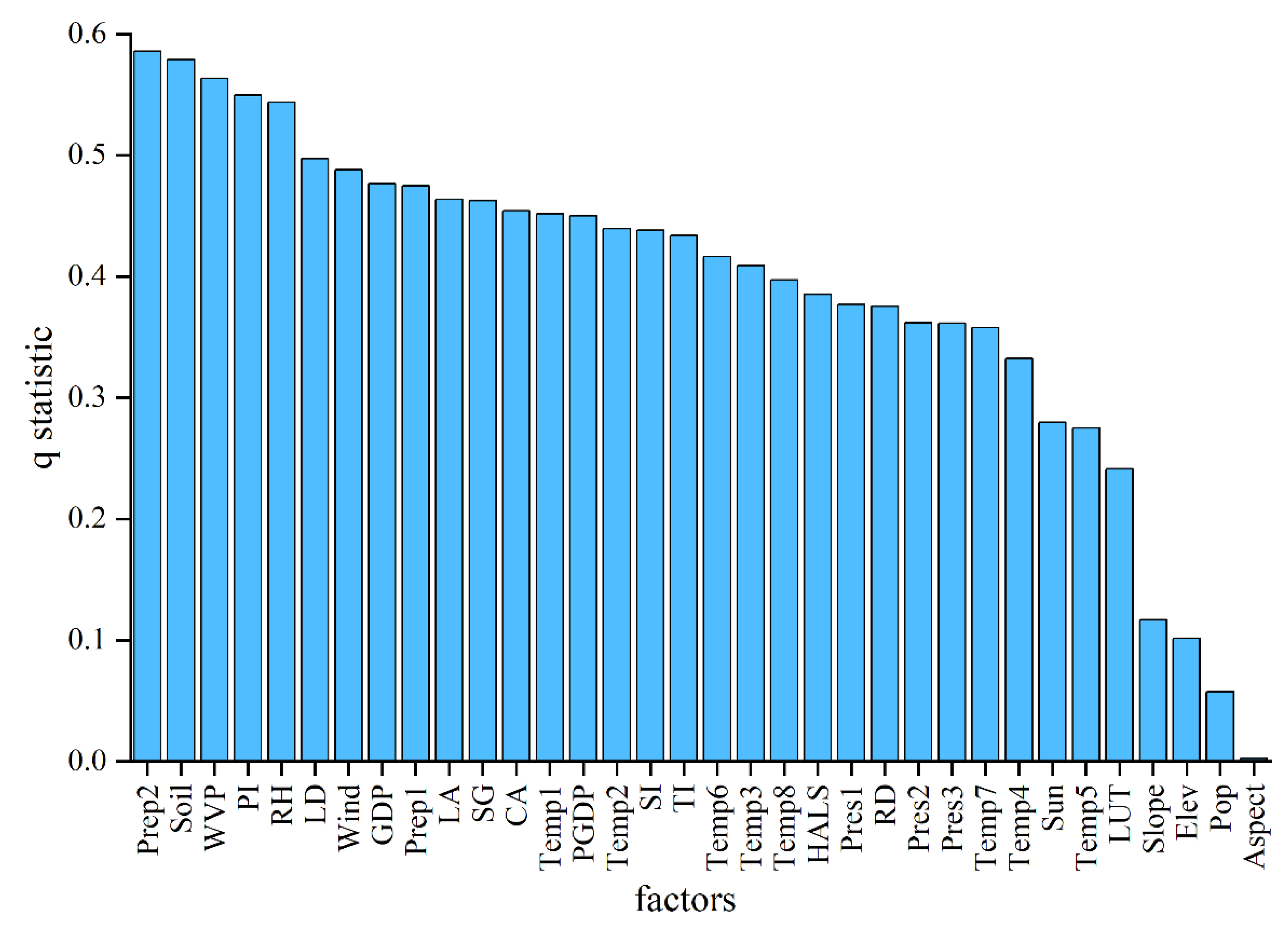
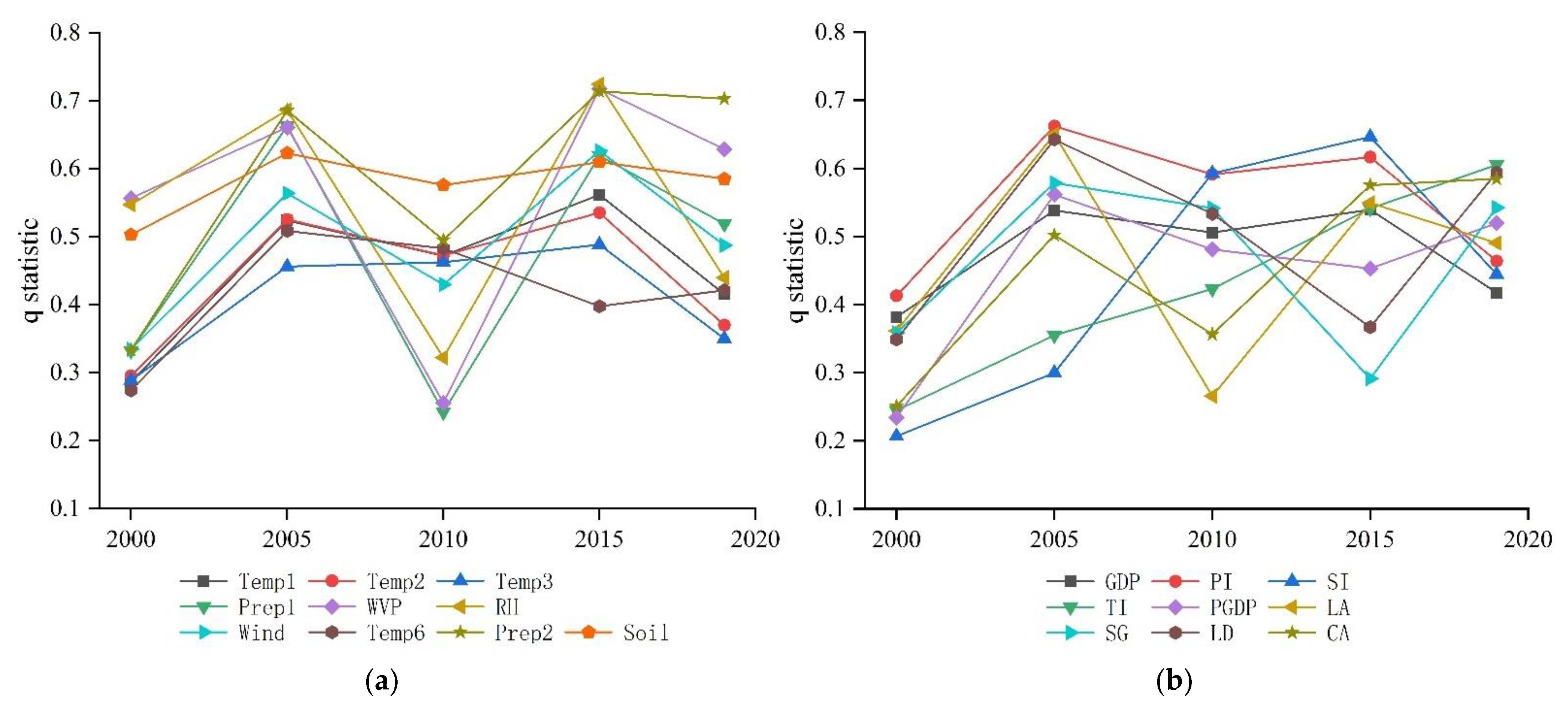
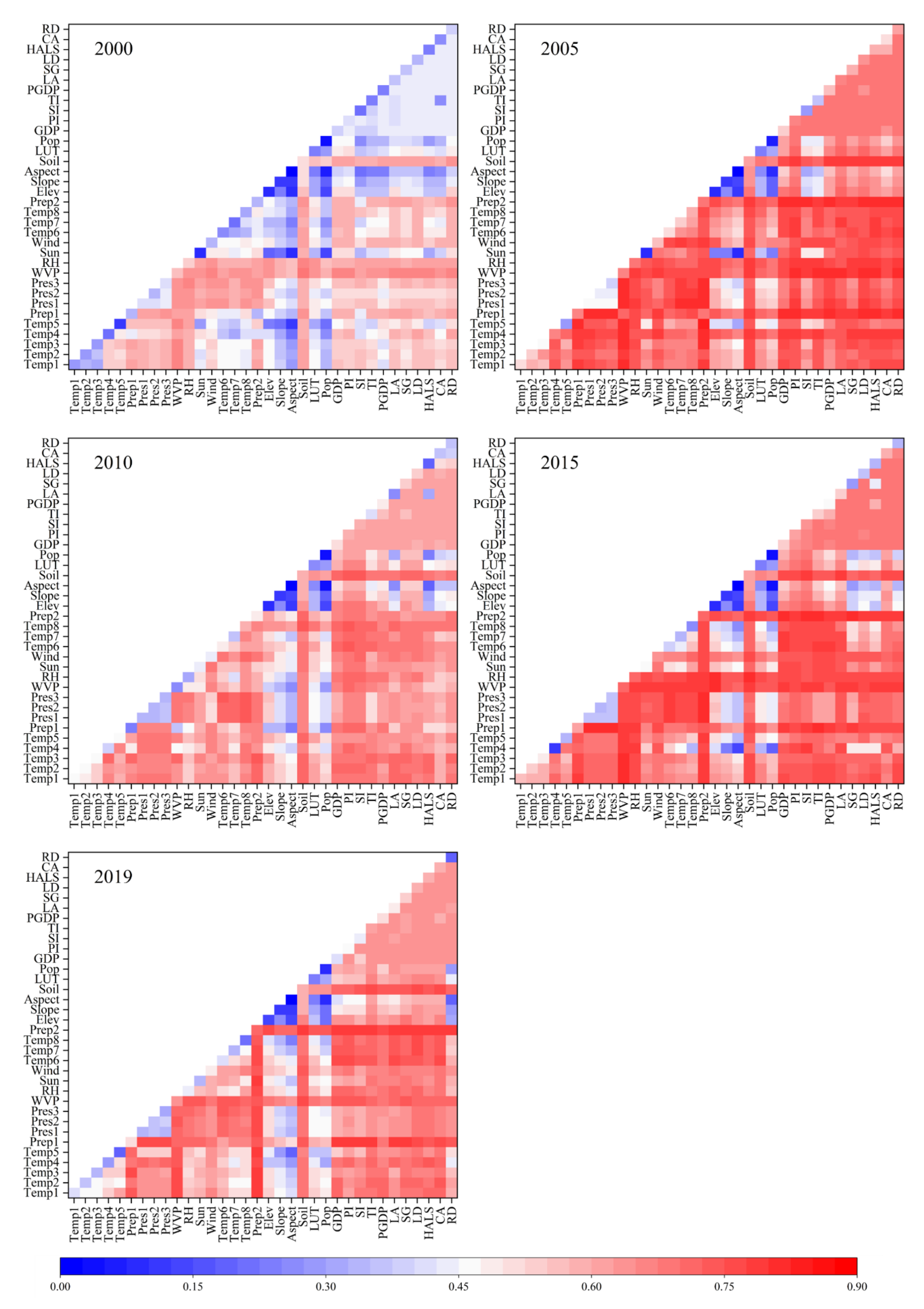

| Interaction | |
|---|---|
| Non-linear weakening | |
| Single-factor nonlinear attenuation | |
| Two-factor enhancement | |
| Independent | |
| Non-linear enhancement |
| Type | Factors | Abbreviation | Unit |
|---|---|---|---|
| Climate Change | Annual Mean Temperature | Temp1 | °C |
| Annual Mean Maximum Temperature | Temp2 | °C | |
| Annual Mean Minimum Temperature | Temp3 | °C | |
| Annual Maximum Temperature | Temp4 | °C | |
| Annual Minimum Temperature | Temp5 | °C | |
| Annual Precipitation | Prep1 | mm | |
| Annual Mean Air Pressure | Pres1 | hpa | |
| Annual Maximum Air Pressure | Pres2 | hpa | |
| Annual Minimum Air Pressure | Pres3 | hpa | |
| Annual Mean Water Vapor Pressure | WVP | hpa | |
| Annual Mean Relative Humidity | RH | % | |
| Annual Sunshine Hours | Sun | h | |
| Annual Mean Wind Speed | Wind | m/s | |
| Growing Season Mean Temperature | Temp6 | °C | |
| Growing Season Maximum Temperature | Temp7 | °C | |
| Growing Season Minimum Temperature | Temp8 | °C | |
| Growing Season Precipitation | Prep2 | mm | |
| Fundamental Natural Environment | Elevation | Elev | m |
| Slope | Slope | degree | |
| Aspect | Aspect | ° | |
| Soil Type | Soil | categorical | |
| Anthropogenic Activity | Land-use Type | LUT | categorical |
| Population Density | Pop | people/km2 | |
| Gross Domestic Product | GDP | 10,000 yuan | |
| Primary Industry | PI | 10,000 yuan | |
| Secondary Industry | SI | 10,000 yuan | |
| Tertiary Industry | TI | 10,000 yuan | |
| Per Capita GDP | PGDP | yuan | |
| Large Animals | LA | 10,000 heads | |
| Sheep and Goats | SG | 10,000 heads | |
| Livestock Density | LD | heads/km2 | |
| Human Activity Intensity of Land Surface | HALS | % | |
| Cultivated Area | CA | % | |
| Road Density | RD | km/km2 |
| Significant Degradation | General Degradation | No Significant Change | General Restoration | Significant Restoration | |
|---|---|---|---|---|---|
| Dongwuzhumuqin Banner Xiwuzhumuqin Banner Xilinhot | 0.09% | 7.32% | 14.21% | 75.01% | 3.37% |
| 0.44% | 7.40% | 13.06% | 77.52% | 1.58% | |
| 0.22% | 8.07% | 12.91% | 75.50% | 3.30% | |
| Abaga Banner Sunitezuo Banner | 0.04% | 10.72% | 18.44% | 70.57% | 0.23% |
| 0.00% | 4.11% | 34.00% | 61.84% | 0.05% | |
| Suniteyou Banner Erlianhot Xianghuang Banner Zhengxiangbai Banner Zhenglan Banner | 0.00% | 6.74% | 43.76% | 49.35% | 0.14% |
| 0.00% | 1.22% | 21.30% | 77.20% | 0.27% | |
| 0.00% | 16.01% | 31.91% | 52.00% | 0.08% | |
| 0.02% | 14.49% | 22.68% | 62.58% | 0.23% | |
| 0.03% | 6.33% | 13.57% | 75.19% | 4.88% | |
| Taipusi Banner Duolan County | 0.07% | 5.49% | 7.57% | 72.09% | 14.77% |
| 0.11% | 2.87% | 3.44% | 65.71% | 27.87% |
| Factor | Range | Unit |
|---|---|---|
| Prep2 | 314.06–412.64 | mm |
| Soil | Greyzems Luvisols Chernozems | − |
| PI | 9.11–12.87 | 100 million yuan |
| WVP | 6.39–6.65 | hpa |
| RH | 61.49–64.35 | % |
| Prep1 | 413.36–490.91 | mm |
| Temp1 | 0.64–1.61 | °C |
| Wind | 2.51–2.83 | m/s |
| LD | 170–263 | heads/km2 |
| TI | 15.37–16.27 | 100 million yuan |
Publisher’s Note: MDPI stays neutral with regard to jurisdictional claims in published maps and institutional affiliations. |
© 2022 by the authors. Licensee MDPI, Basel, Switzerland. This article is an open access article distributed under the terms and conditions of the Creative Commons Attribution (CC BY) license (https://creativecommons.org/licenses/by/4.0/).
Share and Cite
Wang, K.; Cao, C.; Xie, B.; Xu, M.; Yang, X.; Guo, H.; Duerler, R.S. Analysis of the Spatial and Temporal Evolution Patterns of Grassland Health and Its Driving Factors in Xilingol. Remote Sens. 2022, 14, 5179. https://doi.org/10.3390/rs14205179
Wang K, Cao C, Xie B, Xu M, Yang X, Guo H, Duerler RS. Analysis of the Spatial and Temporal Evolution Patterns of Grassland Health and Its Driving Factors in Xilingol. Remote Sensing. 2022; 14(20):5179. https://doi.org/10.3390/rs14205179
Chicago/Turabian StyleWang, Kaimin, Chunxiang Cao, Bo Xie, Min Xu, Xinwei Yang, Heyi Guo, and Robert Shea Duerler. 2022. "Analysis of the Spatial and Temporal Evolution Patterns of Grassland Health and Its Driving Factors in Xilingol" Remote Sensing 14, no. 20: 5179. https://doi.org/10.3390/rs14205179
APA StyleWang, K., Cao, C., Xie, B., Xu, M., Yang, X., Guo, H., & Duerler, R. S. (2022). Analysis of the Spatial and Temporal Evolution Patterns of Grassland Health and Its Driving Factors in Xilingol. Remote Sensing, 14(20), 5179. https://doi.org/10.3390/rs14205179







